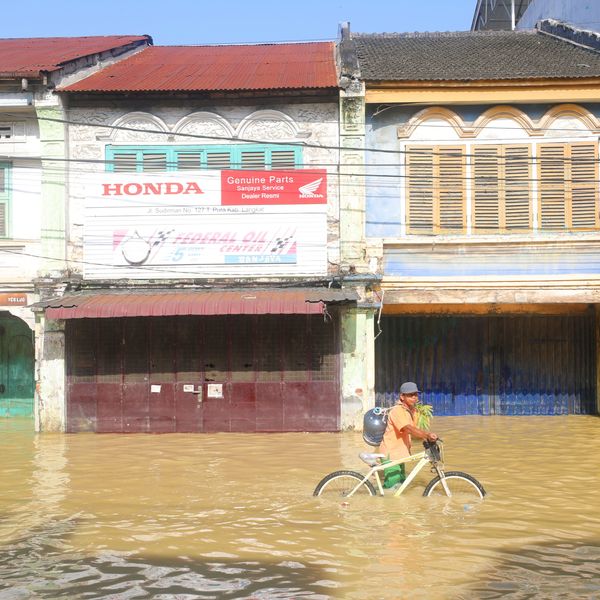'When It Rains, It Pours': Global Warming Brings Increased, Heavier Storms
Report documents increasing and heavier snowstorms and rainstorms since 1948
The impacts of human-caused global warming are being felt across the U.S. as increased and heavier storms -- predicted by climate scientists -- are confirmed in a report released Tuesday.
The report, "When it Rains, it Pours Global Warming and the Increase in Extreme Precipitation from 1948 to 2011" from Environment California Research & Policy Center, shows the effects of a warmer Earth, which is increasing evaporation and causing the atmosphere to hold more moisture. The report shows that extreme rainstorms and snowstorms are happening 30 percent more frequently on average across the contiguous U.S. since 1948; the heavy rainstorms or snowstorms that happened once every 12 months on average in 1948 now happen an average of every 9 months, with the largest annual storms nationwide producing 10 percent more precipitation.
"It's a significant trend, and it's the kind of thing that we can expect more of in the future if we continue to emit lots of global warming pollution," Travis Madsen one of the report's lead authors and a policy analyst at the Frontier Group, said.
The report also finds that 43 states exhibit a significant trend toward more frequent storms with extreme precipitation. New England has been walloped by an increase in severe storms; the region experienced an 85%-increase in extreme rainstorms and snowstorms since 1948, with other regions showing significant increases as well.
"We need to heed scientists' warnings that this dangerous trend is linked to global warming, and do everything we can to cut carbon pollution today," said Nathan Willcox, Federal Global Warming Program Director with Environment America.
* * *
An Urgent Message From Our Co-Founder
Dear Common Dreams reader, The U.S. is on a fast track to authoritarianism like nothing I've ever seen. Meanwhile, corporate news outlets are utterly capitulating to Trump, twisting their coverage to avoid drawing his ire while lining up to stuff cash in his pockets. That's why I believe that Common Dreams is doing the best and most consequential reporting that we've ever done. Our small but mighty team is a progressive reporting powerhouse, covering the news every day that the corporate media never will. Our mission has always been simple: To inform. To inspire. And to ignite change for the common good. Now here's the key piece that I want all our readers to understand: None of this would be possible without your financial support. That's not just some fundraising cliche. It's the absolute and literal truth. We don't accept corporate advertising and never will. We don't have a paywall because we don't think people should be blocked from critical news based on their ability to pay. Everything we do is funded by the donations of readers like you. Will you donate now to help power the nonprofit, independent reporting of Common Dreams? Thank you for being a vital member of our community. Together, we can keep independent journalism alive when it’s needed most. - Craig Brown, Co-founder |
The impacts of human-caused global warming are being felt across the U.S. as increased and heavier storms -- predicted by climate scientists -- are confirmed in a report released Tuesday.
The report, "When it Rains, it Pours Global Warming and the Increase in Extreme Precipitation from 1948 to 2011" from Environment California Research & Policy Center, shows the effects of a warmer Earth, which is increasing evaporation and causing the atmosphere to hold more moisture. The report shows that extreme rainstorms and snowstorms are happening 30 percent more frequently on average across the contiguous U.S. since 1948; the heavy rainstorms or snowstorms that happened once every 12 months on average in 1948 now happen an average of every 9 months, with the largest annual storms nationwide producing 10 percent more precipitation.
"It's a significant trend, and it's the kind of thing that we can expect more of in the future if we continue to emit lots of global warming pollution," Travis Madsen one of the report's lead authors and a policy analyst at the Frontier Group, said.
The report also finds that 43 states exhibit a significant trend toward more frequent storms with extreme precipitation. New England has been walloped by an increase in severe storms; the region experienced an 85%-increase in extreme rainstorms and snowstorms since 1948, with other regions showing significant increases as well.
"We need to heed scientists' warnings that this dangerous trend is linked to global warming, and do everything we can to cut carbon pollution today," said Nathan Willcox, Federal Global Warming Program Director with Environment America.
* * *
The impacts of human-caused global warming are being felt across the U.S. as increased and heavier storms -- predicted by climate scientists -- are confirmed in a report released Tuesday.
The report, "When it Rains, it Pours Global Warming and the Increase in Extreme Precipitation from 1948 to 2011" from Environment California Research & Policy Center, shows the effects of a warmer Earth, which is increasing evaporation and causing the atmosphere to hold more moisture. The report shows that extreme rainstorms and snowstorms are happening 30 percent more frequently on average across the contiguous U.S. since 1948; the heavy rainstorms or snowstorms that happened once every 12 months on average in 1948 now happen an average of every 9 months, with the largest annual storms nationwide producing 10 percent more precipitation.
"It's a significant trend, and it's the kind of thing that we can expect more of in the future if we continue to emit lots of global warming pollution," Travis Madsen one of the report's lead authors and a policy analyst at the Frontier Group, said.
The report also finds that 43 states exhibit a significant trend toward more frequent storms with extreme precipitation. New England has been walloped by an increase in severe storms; the region experienced an 85%-increase in extreme rainstorms and snowstorms since 1948, with other regions showing significant increases as well.
"We need to heed scientists' warnings that this dangerous trend is linked to global warming, and do everything we can to cut carbon pollution today," said Nathan Willcox, Federal Global Warming Program Director with Environment America.
* * *

